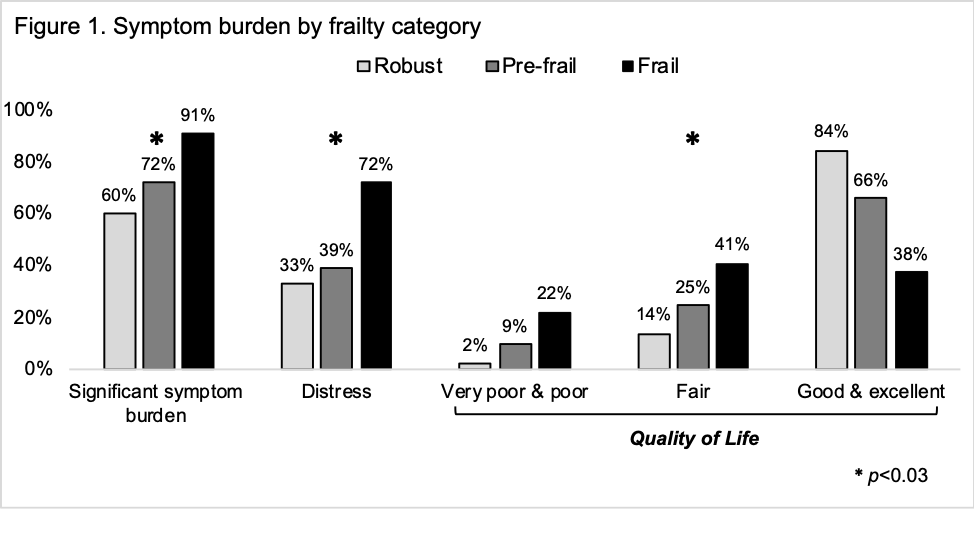Frailty is Strongly Associated with Self-Reported Symptom Burden among Patients with Cirrhosis Undergoing Evaluation for Liver Transplantation
L. X. Deng, K. E. Bischoff, D. S. Kent, D. L. O’Riordan, S. Z. Pantilat, J. C. Lai
University of California, San Francisco, San Francisco, CA
Meeting: 2020 American Transplant Congress
Abstract number: 48
Keywords: Pain, Psychosocial, Quality of life
Session Information
Session Name: Liver: Portal Hypertension and Other Complications of Cirrhosis
Session Type: Oral Abstract Session
Date: Saturday, May 30, 2020
Session Time: 3:15pm-4:45pm
 Presentation Time: 3:27pm-3:39pm
Presentation Time: 3:27pm-3:39pm
Location: Virtual
*Purpose: Among patients with cirrhosis, frailty has most commonly been measured using instruments that focus on malnutrition, muscle wasting, and functional impairment. Little is known about how these frailty domains correlate with patient-reported symptoms.
*Methods: Adult patients with cirrhosis undergoing outpatient evaluation for liver transplantation (LT) from 7/1/19-9/30/19 were eligible for inclusion. Frailty was assessed using the Liver Frailty Index (LFI; grip strength, chair stands, and balance) and categorized as robust (< 3.2), pre-frail (3.2-4.4), and frail (≥ 4.5). Symptom burden was assessed using the Palliative Care Quality Network Symptom and Well-being Survey, a composite of validated measures including the Edmonton Symptom Assessment Scale (ESAS), National Comprehensive Cancer Network Distress Thermometer, and a single-item quality of life measure. We defined a significant symptom burden as a score on the ESAS of ≥ 4 (moderate or severe) in at least one of nine symptoms.
*Results: Of 233 patients (median age 61 years, 43% female, 82% white), median LFI was 3.8 (IQR 3.3-4.2); 22% were robust, 64% pre-frail, and 14% frail. Overall, 72% of patients had a significant symptom burden. Higher frailty categories were associated with increased prevalence of pain, dyspnea, fatigue, nausea, drowsiness, depression, and poor wellbeing (test for trend, all p<0.03). Frail patients were also more likely to report distress and poor quality of life (Figure 1). In univariate analysis, each 0.5 increase in LFI was associated with 35% increased odds of experiencing significant symptom burden (95% CI: 1.1-1.6, p=0.001), which persisted (OR 1.3, 95% CI: 1.0-1.5, p=0.04) even after adjusting for MELD, ascites, hepatic encephalopathy, and dialysis.
*Conclusions: In patients with cirrhosis undergoing LT evaluation, frailty is strongly associated with physical/psychologic symptoms including pain and depression, in addition to poor quality of life; 91% of patients who were frail reported significant symptom burden and 72% reported significant distress. The Liver Frailty Index is a simple, objective metric that can be administered in the clinic setting to identify patients who may benefit from palliative care to address symptoms and improve quality of life.
To cite this abstract in AMA style:
Deng LX, Bischoff KE, Kent DS, O’Riordan DL, Pantilat SZ, Lai JC. Frailty is Strongly Associated with Self-Reported Symptom Burden among Patients with Cirrhosis Undergoing Evaluation for Liver Transplantation [abstract]. Am J Transplant. 2020; 20 (suppl 3). https://atcmeetingabstracts.com/abstract/frailty-is-strongly-associated-with-self-reported-symptom-burden-among-patients-with-cirrhosis-undergoing-evaluation-for-liver-transplantation/. Accessed December 21, 2025.« Back to 2020 American Transplant Congress

